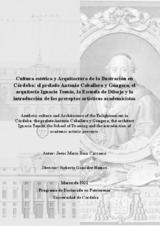Cultura estética y Arquitectura de la Ilustración en Córdoba: el prelado Antonio Caballero y Góngora, el arquitecto Ignacio Tomás, la Escuela de Dibujo y la introducción de los preceptos artísticos academicistas
Aesthetic culture and Architecture of the Enlightenment in Córdoba: the prelate Antonio Caballero y Góngora, the architect Ignacio Tomás, the School of Drawing and the introduction of academic artistic precepts
Autor
Ruiz Carrasco, Jesús María
Director/es
González Ramos, RobertoEditor
Universidad de Córdoba, UCOPressFecha
2021Materia
ArquitecturaCultura estética
Academicismo
Caballero y Góngora, Antonio, 1723-1796
Tomás y Fabregat, Ignacio, 1744-1812
Escuela de Dibujo
Ilustración española
Siglo XVIII
Córdoba (España)
METS:
Mostrar el registro METSPREMIS:
Mostrar el registro PREMISMetadatos
Mostrar el registro completo del ítemResumen
A lo largo de la segunda mitad del siglo XVIII, el contexto artístico español estuvo determinado por el desarrollo y la divulgación de los preceptos academicistas, fundamentados en los principios de la Ilustración. Concretamente, los cambios estéticos promovidos por la Real Academia de San Fernando debían ser formalizados en la arquitectura pública, la cual adquirió un singular protagonismo por su representatividad y su trascendencia social. Sin embargo, la introducción de los nuevos postulados edificatorios oficiales se complicó, demoró o frustró en aquellos territorios donde el decorativismo barroco aún mantuvo su vigencia, tales como alguno de los reinos de Andalucía. Este fue el caso de las jurisdicciones civil y diocesana de Córdoba, donde la tradición constructiva mantuvo su preponderancia hasta el inicio de la última década de la centuria, cuando el prelado Antonio Caballero y Góngora patrocinó un proyecto formativo y profesional de carácter academicista. Para su iniciación, el Prelado eligió a tres artistas formados en la Academia que debían ejercer como profesores de la Escuela de Dibujo en la que se pretendía enseñar los nuevos fundamentos artísticos y autores al servicio de la mitra cordobesa. Uno de los artistas elegidos fue el arquitecto Ignacio Tomás, cuya labor ejercida durante el pontificado de Caballero significó la introducción y parcial implantación de los preceptos constructivos academicistas. Además, el establecimiento de Tomás en Córdoba también implicó un cambio estético notable en la arquitectura de la ciudad de Écija, para la cual proyectó una serie de obras de especial relevancia gracias al intervencionismo regio y académico. De este modo, el último periodo diocesano de Caballero y Góngora, cuyas inclinaciones culturales fueron manifiestas a lo largo de su trayectoria, estuvo protagonizado por el patrocinio de un proyecto academicista que propició la renovación de la actividad artística en Córdoba. Throughout the second half of the 18th century, the Spanish artistic context was determined by the development and dissemination of academic precepts, based on the principles of the Enlightenment. Specifically, the aesthetic changes promoted by the Royal Academy of San Fernando had to be formalized in public architecture, which acquired a unique role due to its representativeness and social significance. However, the introduction of the new official building postulates was complicated, delayed or frustrated in those territories where Baroque decorativeism still maintained its validity, such as some of the kingdoms of Andalusia. This was the case of the civil and diocesan jurisdictions of Córdoba, where the construction tradition maintained its preponderance until the beginning of the last decade of the century, when the prelate Antonio Caballero y Góngora sponsored a training and professional project of an academic nature. For his initiation, the Prelate chose three artists trained at the Academy who were to act as teachers of the School of Drawing in which it was intended to teach the new artistic foundations and authors at the service of the Cordovan miter. One of the chosen artists was the architect Ignacio Tomás, whose work during Caballero's pontificate meant the introduction and partial implementation of academic construction precepts. In addition, the establishment of Tomás in Córdoba also implied a notable aesthetic change in the architecture of the city of Écija, for which he projected a series of works of special relevance thanks to the royal and academic interventionism. In this way, the last diocesan period of Caballero y Góngora, whose cultural inclinations were manifest throughout its trajectory, was led by the sponsorship of an academic project that led to the renewal of artistic activity in Córdoba.

